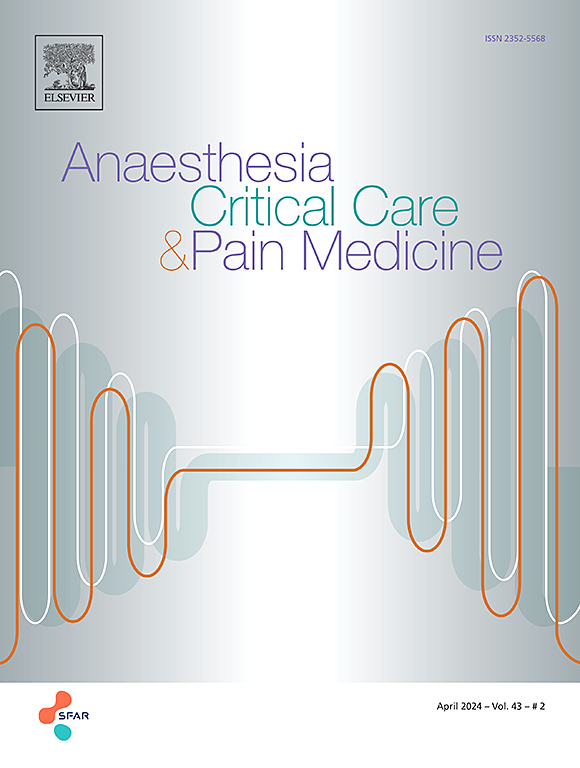Postoperative pulmonary complications in emergency abdominal surgery. A prospective international cohort study
IF 4.7
3区 医学
Q1 ANESTHESIOLOGY
引用次数: 0
Abstract
Background
Emergency abdominal surgery is a high-risk procedure often performed on high-risk patients. The incidence of Postoperative pulmonary complications (PPCs) in emergency abdominal surgery is not well established yet. Several factors, such as the ventilatory approach, may be associated with PPCs but data on patients undergoing emergency abdominal surgery is scarce. The primary aim of the study was to describe the incidence of PPCs during the first 7 postoperative days.
Methods
Prospective international cohort study including all consecutive patients > 18 y/o undergoing emergency abdominal surgery. From April to June 2023 each hospital selected a single 7-day period for the recruitment with a 7-day follow-up. The PPCs included the following international standard definitions for the primary outcome: acute respiratory failure; pneumothorax; weaning failure; acute respiratory distress syndrome; pulmonary infection; atelectasis; pleural effusion; bronchospasm; aspiration pneumonitis; pulmonary thromboembolism; and pulmonary edema.
Results
45 hospitals from 5 geographical areas participated in the study with 507 patients included in the final analysis. A total of 114 (22.5%) patients developed PPCs and 38 (7.5%) developed severe PPCs. The multivariate analysis showed that the independent risk factors for PPCs were: high ARISCAT score (Odds Ratio: 2.67; 95%CI 1.06–6.86), laparotomy (OR: 2.29; 95%CI 1.06–5.01), and postoperative positive air-test (OR: 2.05; 95%CI 1.02–4.24). Conversely, neuromuscular block reversal was associated with a reduced risk of PPCs (OR: 0.36; 95%CI 0.16−0.82).
Conclusion
Incidence of PPCs in patients undergoing emergency abdominal surgery is significant. Among the modifiable risk factors, a lack of neuromuscular block reversal and postoperative positive air test were associated with the increased incidence of PPCs.
急诊腹部手术术后肺部并发症。一项前瞻性国际队列研究。
背景:急诊腹部手术是一项高风险手术,常用于高危患者。急诊腹部手术术后肺部并发症(PPCs)的发生率尚不清楚。一些因素,如通气入路,可能与PPCs有关,但关于接受紧急腹部手术患者的数据很少。该研究的主要目的是描述术后前7天PPCs的发生率。方法:前瞻性国际队列研究,包括所有bb0 - 18y/o连续接受急诊腹部手术的患者。从2023年4月到6月,每所医院选择一个7天的周期进行招募,并进行7天的随访。PPCs包括以下主要结局的国际标准定义:急性呼吸衰竭;气胸;脱机失败;急性呼吸窘迫综合征;肺部感染;肺不张;胸腔积液;支气管痉挛;吸入性肺炎;肺血栓栓塞;还有肺水肿。结果:来自5个地理区域的45家医院参与了研究,最终分析了507例患者。114例(22.5%)患者发生PPCs, 38例(7.5%)患者发生重度PPCs。多因素分析显示,PPCs的独立危险因素为:ARISCAT评分高(优势比:2.67;95%CI 1.06-6.86),剖腹手术(OR:2.29;95%CI 1.06-5.01),术后空气试验阳性(OR:2.05;95%可信区间1.02 - -4.24)。相反,神经肌肉阻滞逆转与PPCs风险降低相关(OR:0.36;95%可信区间0.16 - -0.82)。结论:急诊腹部手术患者PPCs发生率较高。在可改变的危险因素中,缺乏神经肌肉阻滞逆转和术后空气试验阳性与PPCs发生率增加有关。
本文章由计算机程序翻译,如有差异,请以英文原文为准。
求助全文
约1分钟内获得全文
求助全文
来源期刊

Anaesthesia Critical Care & Pain Medicine
ANESTHESIOLOGY-
CiteScore
6.70
自引率
5.50%
发文量
150
审稿时长
18 days
期刊介绍:
Anaesthesia, Critical Care & Pain Medicine (formerly Annales Françaises d''Anesthésie et de Réanimation) publishes in English the highest quality original material, both scientific and clinical, on all aspects of anaesthesia, critical care & pain medicine.
 求助内容:
求助内容: 应助结果提醒方式:
应助结果提醒方式:


